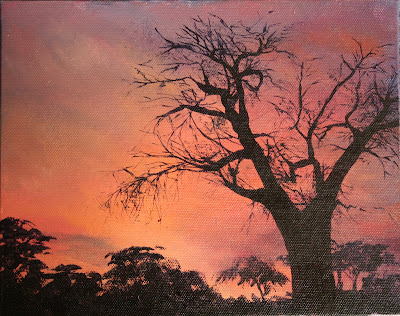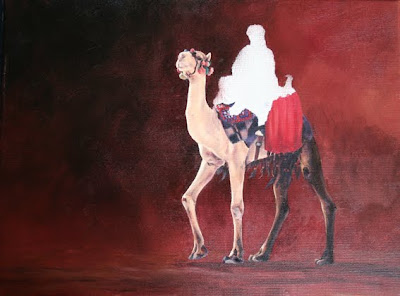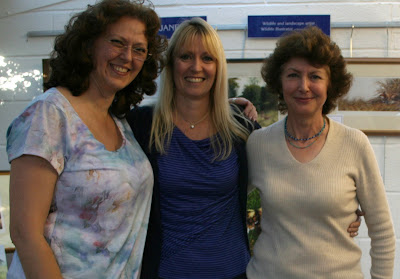I stayed with Frances and her husband all week, which was lovely as I was spoilt with accommodation and good home-cooked food all week! We had good weather, despite horrible weather forecasts saying it would be otherwise and each day we were inundated with visitors. Many familiar faces came to see us and we met a lot of new and interesting folk too. If any of you are reading this... many many thanks for coming to see and talk to us and we hope you enjoyed seeing our work. After setting up on Monday afternoon, it was back to Frances' house to have a quick bite to eat and tidy myself up as I was giving a talk on my work at the zoo to the Wallsworth Art Group in the evening.
Then on the Tuesday it was time to settle to some painting, in between chatting to my fellow AIR's and the folks who came to see us. I decided to try out a new medium (to me) during the week - water mixable oil colours. I have these in mind to take on my Africa trip early next year, so I wanted to try them out. I started first with a simple sunset on the first day- great for slapping some colours on and seeing how they mixed and blended. I found them much the same as normal oil colours.. except for the novelty of using water to wash the brushes in and for thinning the paint when necessary. Took me almost all week to get over that little amusement. Having produced a sunset I was happy with I let it dry overnight and put a very dark purple silhouette of some trees onto it the next day. The drying time is somewhat shorter than normal oils, but I was still able to work on the wet paint for about a day before it started getting a little too tacky. It dried to the touch in about 3 days and by the end of the week the sunset was completely dry with the paint well set.

The trees didn't take very long to do so I spent the rest of the day drawing up a camel and rider for the next stage in playing with the new paints - something with a little more detail and precision. In 2008 I visited the Pyramids of Giza and took many photo's and some video of the camels and riders... I loved the look of them.. almost regal in a way.. so I had in mind a painting or two.. hence all the photo's. Now was the time to paint one. The background was done on Thursday and I decided to go with a strong dark colour to make the camel and rider stand out against it. The original reference has too much clutter behind and the colours were very light making the subject disappear into the picture. I want this piece to be about the camel particularly and so the background needed to be simple yet have movement in to reflect the camels movement and my choice of colours came from the blanket under the camel's saddle. The camel was started on Friday - hindquarters first. The front of the camel was done on Saturday and the blankets and camel bridle with pompoms on Sunday.

Since getting back home after our AIR stint ended on Sunday, I have been looking at and mulling over the dark hindquarters of the animal. It was worrying me. So I spent some hours on the internet trawling through countless pictures of camels and reading camel information... seems the camel I photographed is very unusual. Of the, what must be hundreds of, pictures I viewed I found only two or three photo's of a camel with darker hind-quarters than the rest of the body.... and some info regarding the old tradition of killing camel calves with dark hair mixed in with the lighter hair. Maybe this is why camels tend to be one colour over the body whether it is white, blonde, tawny, brown or black. They had been selectively bred to be of one colour.
SO....... though my colouration is accurate to the original animal.. it is not typical, from what I can see. Therefore for the painting make more sense to the viewer, I will now re-paint the hind-quarters to look like a normal camel. Whilst looking through all those photo's I also decided that I will add a few more decorations to the camel's attire and the suggestion a visitor made to cover the rider's face is growing on me. A few had commented that the background looks like a swirling dust storm that the camel is emerging from... so covering the rider's face would enhance this suggestion... liking this idea more and more.
Despite missing the "normality" of doing my AIR week with Julie, I had a great time with Frances and Linda, both of whom are lovely, happy and fun ladies. We laughed so much during the week and by the end it was strange to think that we had not been friends for a long time. Great week- the company, weather, visitors, venue and food - all superb. Thanks to all.


















































